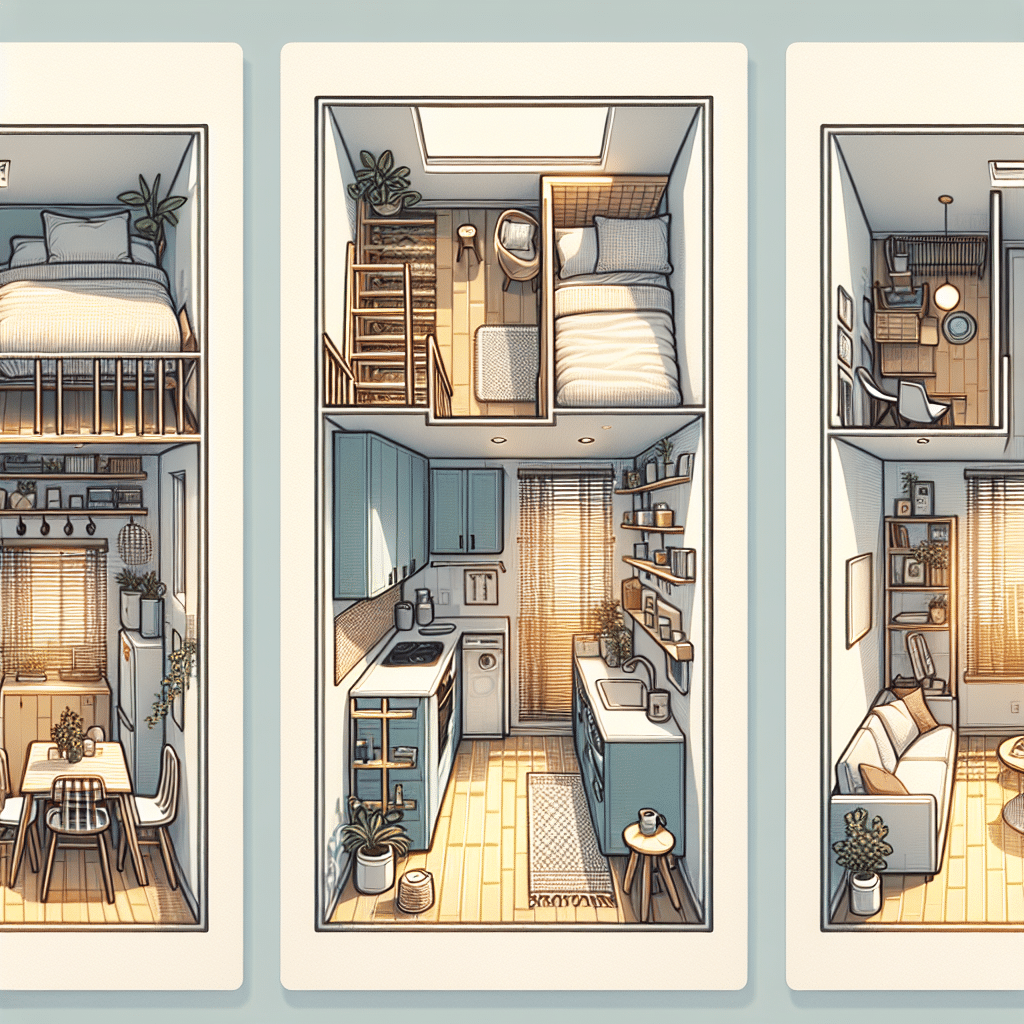Best Layouts for Tiny Apartments
Maximizing space in a tiny apartment can be daunting, but with thoughtful design and creativity, it can also be fun and fulfilling. Applying these effective layouts can help transform limited square footage into a functional and stylish living space.
Open-Concept Living
One of the most popular layouts for tiny apartments is the open-concept design. This layout eliminates walls separating the living area, kitchen, and dining room, creating a seamless flow between spaces. The benefits include enhanced natural light, which makes spaces feel larger, and the ability to multitask easily.
- Zoning Your Space: Use rugs, furniture positioning, or decorative dividers to define specific areas without adding physical barriers.
- Storage Solutions: Opt for built-in cabinets that blend into the walls to prevent overcrowding.
- Multifunctional Furniture: Choose a dining table that doubles as a workspace to maximize utility.
Studio Layouts
A studio apartment typically combines living and sleeping areas into one confined space, presenting unique design opportunities:
- Lofted Beds: Elevate your bed for additional floor space. Use the area beneath for a desk, a seating area, or storage.
- Sliding Partitions: Use screens or sliding doors to separate the sleeping quarters from the living space when needed, which offers privacy without the permanence of walls.
- Compact Appliances: Small, efficient appliances can free up counter space and maintain a clean visual line.
L-Shaped Layout
For those fortunate enough to have a bit more width, an L-shaped layout can effectively segment living spaces while allowing for distinct areas:
- Corner Sofas: Use a corner sofa to make the best use of the room’s geometry, creating comfortable seating without adding to the clutter.
- Angle Dining Tables: Instead of traditional square tables, consider round or triangular tables that can fit snugly into corners.
- Decorative Shelving: Wall-mounted shelves or corner units can provide storage without taking up floor space.
Multi-Level Layouts
A multi-level design can introduce dynamic changes in your apartment’s character and usability.
- Mezzanine Spaces: If your ceiling height permits, a raised loft creates a separate sleeping area, maximizing available room for living or storage below.
- Split-Level Floors: A split-level arrangement can delineate spaces for different functions, offering a visually appealing tiered effect. Use steps as storage solutions, keeping your space organized and stylish.
Minimalist Design
Adopting a minimalist approach focuses on functionality while maintaining aesthetics, essential for tiny apartments.
- Essentials Only: Limit decor and furniture to the essentials; less is more in terms of visual clutter.
- Neutral Colors: A neutral palette can make the space appear larger and more cohesive. Layer textures to add depth without overwhelming.
- Hidden Storage: Invest in furniture that conceals items, such as storage ottomans or beds with drawers underneath.
Defined Entryways
Often overlooked, a well-defined entryway is crucial in tiny apartments.
- Wall Hooks and Shelves: Install a row of hooks for bags and coats to avoid clutter at the entrance. A small shelf for keys or mail can also streamline access.
- Benches: A slim bench can offer a place to sit while putting on shoes and can double as a storage solution.
Flexible Living Areas
Flexibility is critical in tiny apartments. By designing spaces that can serve multiple purposes.
- Folding Furniture: Tables and chairs that fold away can clear room for activities when not in use, making your space versatile.
- Murphy Beds: These beds can be entirely hidden when not in use, allowing a small bedroom to become a multifunctional space during the day.
- Dual-Purpose Rooms: For example, a home office can transform into a guest bedroom. Use rollaway beds or a sofa bed for easy conversions.
Creative Bathroom Solutions
Even bathrooms in tiny apartments can be designed to maximize space.
- Compact Fixtures: Consider corner sinks and showers to make the most of the area available.
- Storage Niches: Built-in shelves or cabinets can keep toiletries organized while ensuring the room remains visually appealing.
Natural Lighting Techniques
Light can dramatically alter the perception of space; thus, maximizing natural light is crucial.
- Mirrors: Strategically placed mirrors enhance brightness and give the illusion of more space.
- Sheer Curtains: To allow natural light in while maintaining privacy, opting for sheer rather than heavy drapery is often beneficial.
Outdoor Extensions
If your tiny apartment is near outdoor spaces, maximizing these can expand your living area.
- Balcony Design: A small balcony can be transformed into an oasis with outdoor furniture, plants, or even vertical gardens.
- Rooftop Gardens: Use common areas in apartment buildings for gatherings and relaxation by creating a community garden or lounging space.
Efficient Use of Vertical Space
In tiny apartments, going vertical is often the best way to maximize storage and functionality.
- Tall Cabinets: Invest in tall storage units that reach the ceiling to utilize vertical space and keep items out of sight.
- Wall-Mounted Desks: Consider installing a desk that can be folded up when not in use, creating a workspace that doesn’t take over the room.
Personal Touches
Even in a small area, personalization can create an inviting atmosphere:
- Art Display: Curate a selection of your favorite artwork on walls to add character without occupying space.
- Textiles: Incorporate color and warmth with throw pillows and blankets.
Crafting a comfortable and functional layout in a tiny apartment doesn’t have to be overwhelming. By utilizing these smart design strategies, every square inch can become a vital part of your home, creating a open, inviting, and efficient living space. Each layout option not only adheres to spatial limitations but also personalizes your environment for an enhanced living experience.
